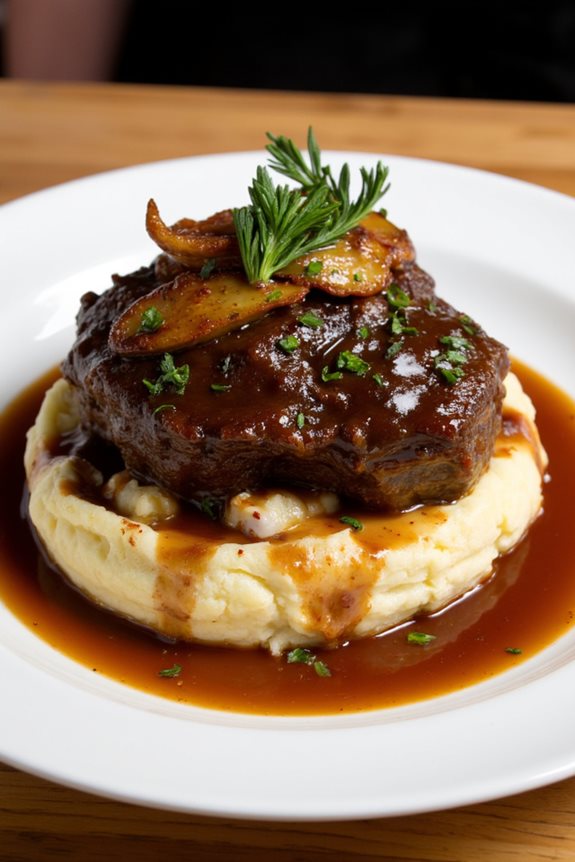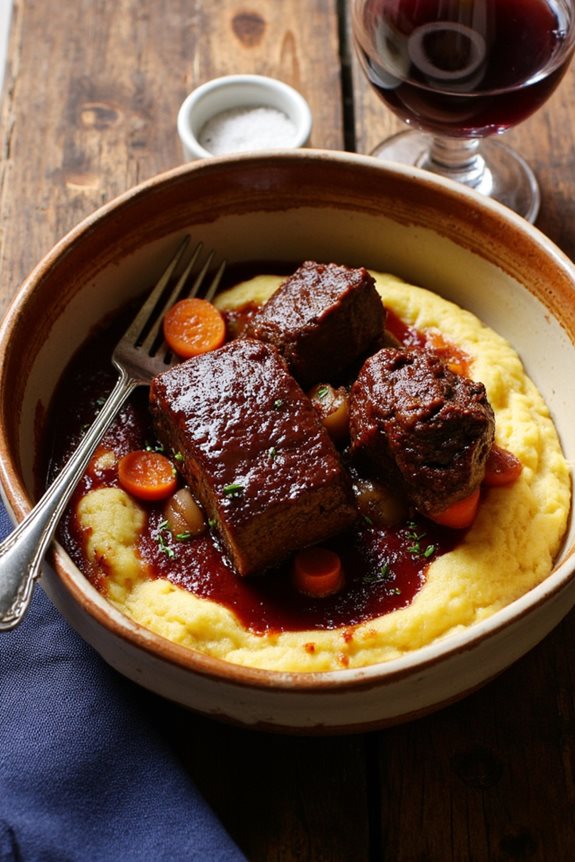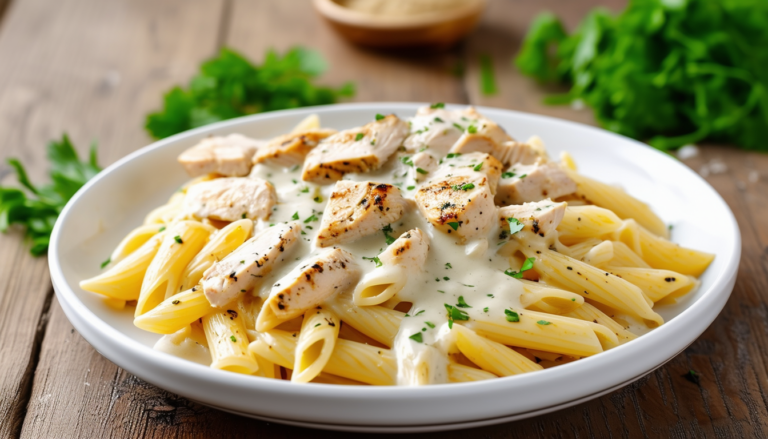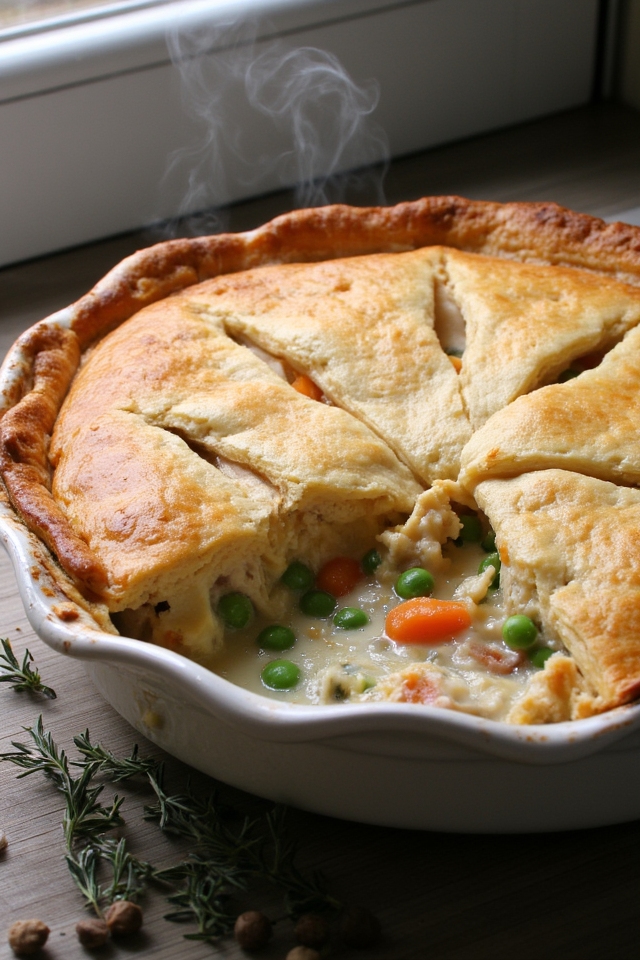I’m obsessed with braised short ribs – they’re my ultimate comfort food when the weather turns chilly.
There’s something magical about transforming those tough, collagen-rich cuts into fork-tender morsels that practically melt in your mouth.
The process isn’t complicated, but it does require patience and a bit of technique to coax out that deep, rich flavor.
Ready to discover my foolproof method that’ll have your dinner guests wondering if you’ve been hiding professional culinary training?
Why You’ll Love These Short Ribs
- Melt-in-your-mouth tenderness – The slow braising process transforms tough cuts into incredibly tender, fall-off-the-bone meat that practically melts on your tongue.
- Impressive results with minimal effort – While it looks and tastes like you spent all day cooking, the actual hands-on time is surprisingly minimal – just sear, add ingredients, and let time do the work.
- Budget-friendly comfort food – Short ribs are an affordable cut that feeds a crowd, making this an economical choice for family dinners without sacrificing flavor or satisfaction.
- Perfect for any occasion – This dish works beautifully for casual Sunday family meals or elegant dinner parties, adapting seamlessly from rustic comfort to sophisticated entertaining.
- Rich in protein and flavor – The marbled meat provides excellent protein content while developing deep, complex flavors that create that irresistible aroma filling your kitchen.
What Ingredients are in Short Ribs?
When I’m creating braised short ribs for my family, I’m always looking for that perfect balance of rich, savory flavors that’ll have my daughters asking for seconds.
The beauty of this recipe lies in its simplicity—quality ingredients doing what they do best when given enough time.
As a Wisconsin native who values farm-to-table cooking, I try to source as many ingredients as possible from local farmers and producers, which makes a difference in the final dish.
I also recommend using premium cast iron cookware for the best heat distribution and flavor development when braising.
- 4-5 pounds bone-in beef short ribs (preferably from a local Wisconsin farm)
- 2 tablespoons vegetable oil or bacon fat
- 2 large onions, roughly chopped
- 3 carrots, peeled and cut into chunks
- 3 celery stalks, chopped
- 4 garlic cloves, minced
- 2 tablespoons tomato paste
- 2 cups dry red wine (can substitute beef broth)
- 2 cups beef stock or broth
- 3-4 sprigs fresh thyme
- 2 bay leaves
- Salt and freshly ground black pepper
- 2 tablespoons Wisconsin butter (for finishing)
- Optional: 1 tablespoon local honey or maple syrup for depth
- Optional: 2 tablespoons flour for thickening the sauce
The quality of your short ribs makes all the difference in this dish, so I recommend developing a relationship with your local butcher if possible. Look for ribs with good marbling—that’s where all the flavor comes from.
And don’t skimp on the wine; it doesn’t have to be expensive, but it should be something you’d enjoy drinking.
My kids love it when I serve this with creamy mashed potatoes or polenta to soak up all that delicious sauce, but crusty bread works wonderfully too. The recipe is flexible enough that you can add seasonal Wisconsin veggies depending on what looks good at the farmers market that week.
How to Make These Short Ribs

The magic of braised short ribs happens in stages, starting with a good sear. I heat 2 tablespoons of vegetable oil or bacon fat in a large Dutch oven until it’s nearly smoking hot. While that’s heating, I pat my 4-5 pounds of local Wisconsin short ribs completely dry with paper towels and season them generously with salt and pepper.
Working in batches—overcrowding is the enemy of a good sear—I place the ribs in the hot oil and let them develop a deep brown crust on all sides, about 2-3 minutes per side. This initial browning creates those complex flavors we’re after, so I never rush this step, especially when my 7-year-old is hovering nearby asking “how much longer?” The patience pays off, trust me.
Once all the ribs are browned and set aside, I lower the heat to medium and add my 2 large chopped onions, 3 chunky carrots, and 3 chopped celery stalks to the same pot, letting them cook in all those beautiful beef drippings. After about 5 minutes, when the veggies have softened, I add 4 minced garlic cloves and cook for another minute until fragrant.
Then comes 2 tablespoons of tomato paste, which I stir and cook until it darkens slightly—this little step adds incredible depth. I deglaze with 2 cups of dry red wine (or beef broth if cooking for the whole family), scraping up all those flavorful brown bits from the bottom. After the wine reduces by about half, I add 2 cups of beef stock, 3-4 sprigs of fresh thyme, and 2 bay leaves, then nestle the browned ribs back into the liquid.
The final stretch is all about patience. I bring everything to a gentle simmer, cover the pot, and transfer it to a 325°F oven for about 2½ to 3 hours. The ribs are done when the meat is fork-tender and nearly falling off the bone—the kind of tenderness that makes my 5-year-old giggle when she touches it with her fork and it just collapses.
After removing the ribs to a serving platter, I skim excess fat from the surface of the sauce, remove the herb stems, and if I want a thicker sauce, I’ll whisk in 2 tablespoons of flour mixed with a little cold water. A final swirl of 2 tablespoons of Wisconsin butter adds silkiness, and sometimes a tablespoon of local honey or maple syrup rounds everything out.
The sauce gets poured over the ribs, and we’re ready for what’s always a surprisingly quiet dinner—everyone’s too busy savoring each bite to talk much.
AI Recipe Tools
Short Ribs Substitutions and Variations
Not everyone has access to perfect short ribs, which is why knowing your options can save dinner when the butcher gives you that apologetic shrug.
Chuck roast makes an excellent alternative—it’s got similar marbling and that melt-in-your-mouth quality when braised low and slow.
For a Wisconsin twist, I recommend using locally raised beef from our family farms.
Sometimes I’ll swap in venison shoulder during hunting season, though you’ll need to add extra fat.
Flavor variations? Try maple syrup instead of brown sugar, or splash in a local craft beer.
My girls always notice when I use their favorite apple cider reduction.
What to Serve with Short Ribs
Perfect side dishes can turn those succulent short ribs from simply delicious to memorable. I’m a firm believer in pairing these rich, beefy beauties with creamy mashed potatoes or polenta to soak up that divine sauce.
My Wisconsin roots call for local root vegetables—carrots, parsnips, and turnips, roasted until caramelized and sweet.
Need something green? A bright, acidic salad cuts through the richness perfectly. My girls always want crusty bread for sauce-mopping duties, and who can blame them? That sauce is liquid gold, after all. Not a drop wasted in this house.
For a full Wisconsin experience, pair these short ribs with a robust New Glarus Spotted Cow ale or crumble some aged Wisconsin cheddar over those roasted root vegetables—the sharp, nutty flavors complement the beef beautifully.
Can I Use the Same Techniques for Braising Short Ribs to Make Tender Short Rib Burgers?
Absolutely! Using braising techniques to prepare tender short rib burgers can elevate their flavor and texture. Slow-cooking the short ribs beforehand allows the meat to absorb aromatic spices and become extraordinarily tender. Once shredded and mixed with seasonings, these beefy delights transform into irresistible tender short rib burgers.
Final Thoughts
After spending years perfecting this braised short ribs recipe, I’ve come to appreciate how this humble cut transforms into something truly magnificent with just a little patience and technique.
There’s something magical about the way the meat falls off the bone, isn’t there?
Whether you’re feeding a hungry family or impressing dinner guests, these short ribs never disappoint.
My Wisconsin roots have taught me that good food doesn’t need to be complicated—just thoughtfully prepared with quality ingredients.
When my daughters gather around the table, eyes widening at these rich, tender ribs, I’m reminded why I love cooking so much.





